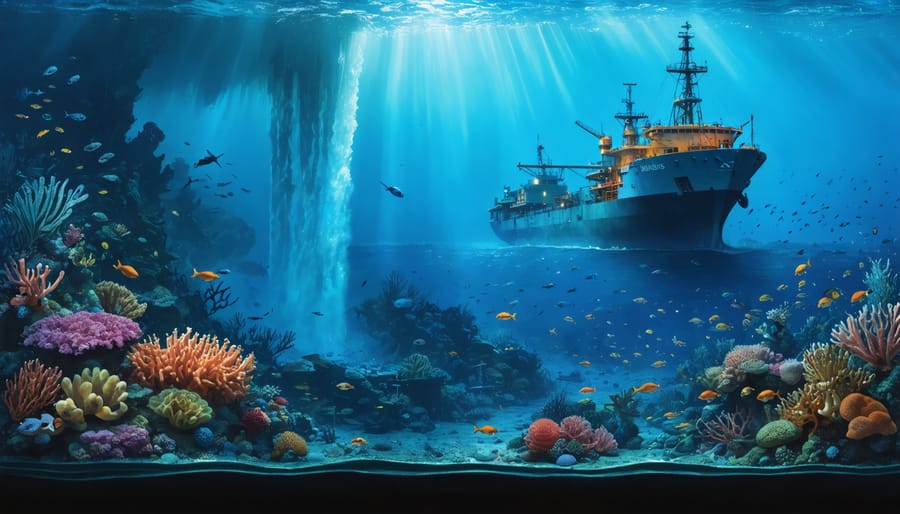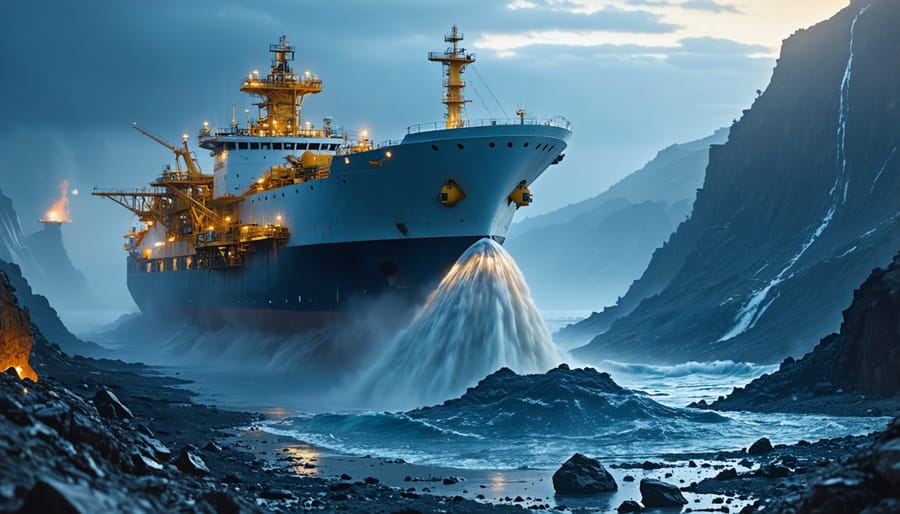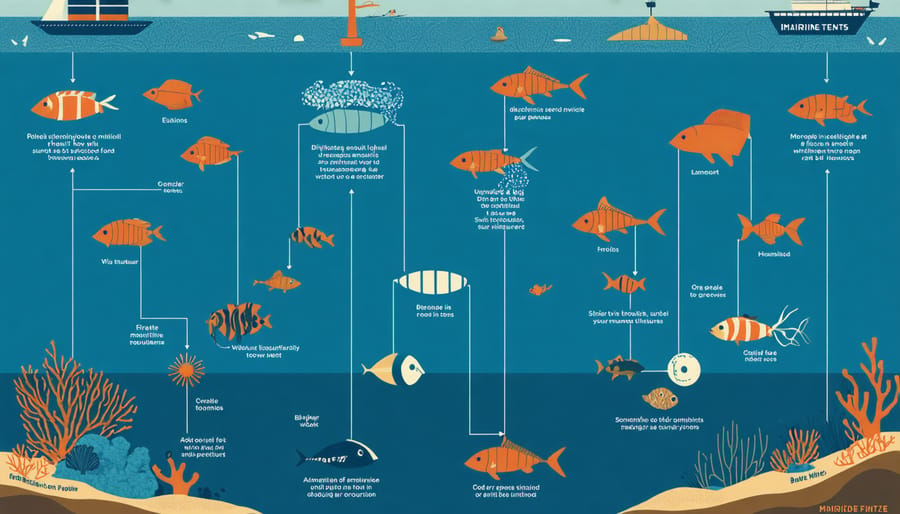
Deep beneath the waves, a controversial gold rush threatens to devastate pristine marine ecosystems as international mining companies race to extract valuable minerals from the ocean floor. Every day, massive underwater machines scrape, drill, and disturb ancient seabeds, releasing plumes of sediment that can travel hundreds of miles, suffocating coral reefs and disrupting complex food chains that have evolved over millions of years. The stakes couldn’t be higher: scientists estimate that a single mining operation can destroy marine habitats the size of New York City within months, while the toxic metals released may persist in ocean waters for centuries. As global demand for electronics and renewable energy technologies surges, we stand at a critical crossroads between technological progress and environmental preservation. The decisions we make today about deep-sea mining will determine the fate of countless marine species, many of which remain undiscovered, and impact the ocean’s vital role in regulating our planet’s climate and supporting billions of people who depend on healthy seas for their survival.
The Deep-Sea Mining Process: Understanding the Threat
Current Mining Technologies
Current deep-sea mining operations primarily utilize two main extraction methods: hydraulic suction and mechanical cutting. Large remotely operated vehicles (ROVs) equipped with powerful suction pumps traverse the ocean floor, collecting mineral-rich nodules and sediments. These machines, some as large as small houses, create significant disturbance to the seafloor ecosystem.
The hydraulic systems use high-pressure water jets to loosen sediments and minerals, which are then pumped through flexible pipes to surface vessels. This process creates plumes of suspended particles that can spread for kilometers, affecting marine life far beyond the mining site.
Mechanical cutters, designed for harder deposits like sulfide mounds, employ rotating heads with tungsten carbide teeth. These machines grind and break apart the seafloor, creating a destructive path through delicate marine habitats. The extracted material is then transported to the surface through a system of vertical riser pipes.
Support vessels floating above the mining sites process the collected materials, separating valuable minerals from sediment. The waste material, often containing heavy metals and other pollutants, is sometimes discharged back into the ocean, creating additional environmental stress on marine ecosystems.

Target Resources and Extraction Zones
Ocean mining operations primarily target valuable minerals and metals found in diverse marine environments. The most sought-after resources include polymetallic nodules, rich in nickel, copper, cobalt, and manganese, which scatter across vast abyssal plains at depths of 4,000-6,000 meters. These nodules, formed over millions of years, are particularly abundant in the Clarion-Clipperton Zone (CCZ) of the Pacific Ocean.
Seafloor massive sulfides, found near hydrothermal vents, contain high concentrations of copper, zinc, lead, gold, and silver. These deposits typically occur at depths of 1,500-5,000 meters, with significant formations in the Atlantic and Pacific Oceans. The Southwest Indian Ridge and the Mid-Atlantic Ridge host some of the largest known deposits.
Cobalt-rich crusts, forming on the flanks of seamounts, represent another vital resource. These crusts, found at depths of 800-2,500 meters, contain critical materials for renewable energy technologies and electronic devices. The Prime Crust Zone in the Pacific Ocean holds particularly rich deposits.
Marine phosphorites, essential for agricultural fertilizers, are typically extracted from shallower continental shelf areas. Major extraction zones include the continental margins off Namibia, South Africa, and New Zealand.
These extraction zones often overlap with critical marine habitats and biodiversity hotspots, raising significant environmental concerns. The CCZ alone hosts over 1,000 species previously unknown to science, highlighting the potential biodiversity loss from mining activities.
Direct Environmental Impacts
Sediment Plumes and Water Quality
Deep-sea mining operations create massive sediment plumes that can spread far beyond the immediate mining site, causing significant disruption to marine ecosystems. When mining vehicles disturb the seafloor, they release fine particles that can remain suspended in the water column for extended periods, sometimes traveling hundreds of kilometers from the source.
These sediment plumes pose several serious threats to marine life and water quality. The suspended particles reduce light penetration, affecting photosynthetic organisms and disrupting the marine food chain. Marine creatures, particularly filter feeders like corals and sponges, can become clogged or smothered by the excessive sediment, leading to decreased feeding efficiency and potential death.
The chemical composition of these plumes presents another concern. Deep-sea sediments often contain heavy metals and other toxic compounds that have accumulated over millions of years. When disturbed, these contaminants can be released into the water column, potentially poisoning marine life and altering the chemical balance of the surrounding waters.
Research conducted by marine biologists has shown that sediment plumes can persist in the water column for months, creating long-lasting “underwater clouds” that affect water quality and visibility. Dr. Sarah Chen, a deep-sea ecologist, notes: “The impact of these plumes extends far beyond what we initially anticipated. We’re seeing effects on marine life at distances we never expected.”
Monitoring studies have revealed that areas affected by mining-related sediment plumes show significantly reduced biodiversity compared to undisturbed regions, with some species taking years to recover, if at all. This highlights the urgent need for strict regulations and improved mining technologies to minimize sediment disturbance and protect marine ecosystems.

Habitat Destruction
Ocean mining operations cause devastating physical damage to marine habitats, disrupting delicate ecosystems that have taken millennia to develop. The heavy machinery used in deep-sea mining crushes and destroys everything in its path, from ancient coral reef ecosystems to complex seafloor communities.
The impact extends far beyond the immediate mining site. As massive excavators and collectors scrape the seafloor, they create large plumes of sediment that can travel for kilometers, smothering marine life and reducing visibility for filter-feeding organisms. These sediment clouds can take months or even years to settle, effectively creating dead zones where once-thriving communities existed.
Deep-sea habitats are particularly vulnerable because they’ve evolved under stable conditions over millions of years. The seafloor’s physical structure, once destroyed, can take centuries to recover – if recovery is possible at all. Mining operations targeting polymetallic nodules remove these natural formations entirely, eliminating crucial microhabitats for countless species.
The destruction affects all levels of marine life. Bottom-dwelling organisms lose their homes, while mobile species lose their feeding grounds and breeding sites. The removal of nodules eliminates surfaces where larvae settle and grow, breaking critical links in the marine ecosystem’s life cycle.
Recent surveys by marine biologists have revealed that even small-scale experimental mining sites from decades ago show minimal signs of recovery, highlighting the long-lasting nature of habitat destruction. This underscores the urgent need for careful consideration of mining practices and the implementation of strict protective measures to preserve these irreplaceable marine environments.
Long-term Effects on Marine Life
Species Displacement and Extinction Risks
Deep-sea mining activities pose severe threats to marine ecosystems, leading to unprecedented levels of marine biodiversity loss in affected areas. When mining operations disturb the seafloor, they can destroy entire communities of deep-sea creatures, many of which are yet to be discovered by science.
Species particularly vulnerable to mining impacts include deep-sea corals, which can take centuries to grow, and unique chemosynthetic communities that thrive around hydrothermal vents. These ecosystems often harbor endemic species – organisms found nowhere else on Earth – making their displacement especially concerning for marine conservation efforts.
The destruction of these habitats can trigger a cascade of ecological effects. Many deep-sea species depend on specific substrate types or environmental conditions that mining activities irreversibly alter. For example, bottom-dwelling fish lose their breeding grounds, while filter-feeding organisms struggle to survive in waters clouded by sediment plumes.
Marine biologist Dr. Sarah Chen notes, “What we’re seeing is not just the immediate impact on visible species, but the disruption of entire food webs that have evolved over millions of years.” Some estimates suggest that areas affected by deep-sea mining may take thousands of years to recover, if they recover at all.
The risk of extinction is particularly high for species with limited ranges or slow reproduction rates. Many deep-sea organisms are extremely specialized to their environments, making them unable to adapt to sudden changes or relocate to new areas when their habitats are destroyed.

Ecosystem Chain Reactions
Ocean mining pollution triggers far-reaching chain reactions that extend well beyond the immediate mining sites. The disruption of marine ecosystems creates a domino effect that impacts species across multiple trophic levels, from microscopic plankton to apex predators.
When mining operations disturb the seafloor, they release sediment plumes that can travel hundreds of kilometers, affecting filter-feeding organisms like corals, sponges, and shellfish. These creatures form the foundation of complex marine food webs, and their decline reverberates throughout the entire ecosystem. For instance, when filter feeders struggle, the populations of fish that depend on them for food also decrease, affecting commercial fisheries and marine mammals higher up the food chain.
The release of toxic metals and chemicals during mining operations can bio-accumulate in marine organisms, becoming increasingly concentrated at each trophic level. Small fish absorb these toxins, which then become more concentrated in larger predatory fish, eventually affecting sea birds and marine mammals that feed on them.
Deep-sea mining also disrupts crucial carbon sequestration processes. The ocean floor acts as a natural carbon sink, and when disturbed, it can release stored carbon back into the water column, potentially contributing to ocean acidification and climate change. This creates a feedback loop that further stresses marine ecosystems, making them more vulnerable to other environmental pressures.
The recovery of these deep-sea ecosystems can take decades or even centuries, emphasizing the need for careful consideration of mining practices and their long-term consequences.
Solutions and Conservation Efforts
Regulatory Frameworks
The International Seabed Authority (ISA), established under the United Nations Convention on the Law of the Sea (UNCLOS), currently oversees deep-sea mining activities in international waters. As of 2023, the ISA has implemented a Mining Code that sets environmental standards and requires environmental impact assessments before mining operations can begin.
Several countries have also developed their own regulatory frameworks for mining activities within their exclusive economic zones. For instance, New Zealand has established strict environmental protection measures, requiring comprehensive environmental studies and ongoing monitoring of mining operations.
However, many experts argue that current regulations are insufficient to protect marine ecosystems. The Deep Sea Conservation Coalition, comprising over 60 international organizations, advocates for stronger protective measures and a moratorium on deep-sea mining until more comprehensive scientific research is completed.
Emerging regulatory proposals include the establishment of protected areas around mining sites, mandatory restoration requirements, and real-time environmental monitoring systems. The European Union is currently developing additional guidelines that could serve as a model for international standards, emphasizing the precautionary principle and ecosystem-based management approaches.
Alternative Technologies
As the environmental impact of traditional ocean mining becomes increasingly apparent, researchers and companies are developing innovative alternatives that minimize harm to marine ecosystems. Robotics and artificial intelligence are leading the way, with autonomous underwater vehicles (AUVs) designed to collect minerals with precision, reducing the disturbance to seafloor habitats.
One promising approach is biomimetic mining, which takes inspiration from marine organisms. These systems emulate natural filtering processes used by creatures like sea cucumbers, allowing for gentler mineral extraction while preserving delicate marine environments. Additionally, in-situ leaching technologies are being refined to extract minerals through controlled dissolution rather than physical disruption of the seabed.
Surface-based alternatives are also emerging, including advanced mineral processing from seawater and the development of artificial upwelling systems. These methods can harvest minerals from ocean water without disturbing the seafloor ecosystem. Some companies are even exploring the potential of cultivating metal-accumulating organisms, a process known as phytomining, which could provide a sustainable way to gather valuable minerals while potentially helping to clean ocean waters.
These innovative approaches demonstrate that economic interests and environmental protection can coexist through thoughtful technological advancement.
The devastating impacts of ocean mining pollution on marine ecosystems demand immediate attention and action from the global community. Throughout this exploration of deep-sea mining’s environmental consequences, we’ve seen how sediment plumes, toxic metal release, and habitat destruction threaten countless marine species and delicate deep-sea environments.
However, there is hope for positive change through collective action and innovative solutions. The growing awareness of ocean mining’s environmental costs has already led to improved regulations and monitoring systems. Scientific research continues to unveil the intricate connections between deep-sea ecosystems and global ocean health, strengthening the case for conservation.
You can make a difference by supporting marine conservation initiatives, staying informed about ocean mining policies, and sharing knowledge with others. Consider joining local beach cleanups, participating in citizen science projects, or supporting organizations working to protect marine biodiversity. Every action counts, from reducing your plastic consumption to advocating for stricter mining regulations.
The future of our oceans depends on the choices we make today. By implementing sustainable mining practices, advancing clean technologies, and prioritizing marine ecosystem protection, we can ensure the preservation of these vital underwater worlds for generations to come. Let’s work together to protect our ocean’s biodiversity while pursuing responsible resource management strategies that benefit both humanity and marine life.
Join the movement to safeguard our oceans. Your voice and actions matter in the fight for marine conservation.
jessica
Ava Singh is an environmental writer and marine sustainability advocate with a deep commitment to protecting the world's oceans and coastal communities. With a background in environmental policy and a passion for storytelling, Ava brings complex topics to life through clear, engaging content that educates and empowers readers. At the Marine Biodiversity & Sustainability Learning Center, Ava focuses on sharing impactful stories about community engagement, policy innovations, and conservation strategies. Her writing bridges the gap between science and the public, encouraging people to take part in preserving marine biodiversity. When she’s not writing, Ava collaborates with local initiatives to promote eco-conscious living and sustainable development, ensuring her work makes a difference both on the page and in the real world.
